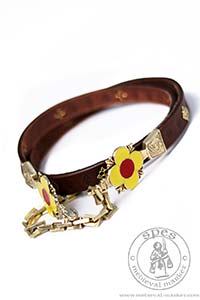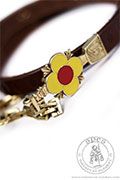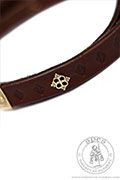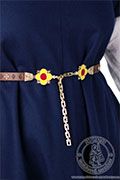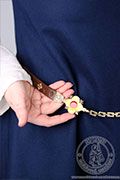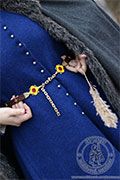This website uses cookies according to the Privacy Policy. By continuing to use the site you are agreeing to our use of cookies.
If you wish to adjust your cookie preferences for this website, you can do so using your browser settings.
If you wish to adjust your cookie preferences for this website, you can do so using your browser settings.



×
Automatic translation may cause errors - if you have encountered difficulties in placing an order, turn off these options in your browser.
Category: Accessories > belts
Medieval girdle belt
Medieval girdle belt
Century: XIV, XV| CODE | Material |
Standard
|
Price | |
| KoS1611 | see description | Mixed | 135.00 EUR |
|
Lowest price in the last 30 days
See how to place an order for several people
Leather belt for a woman, especially reenacting court lady or rich townswoman. This girdle is fastened at the waist or lower with medallions in a flower shape. It has a chain to adjust the girth.
Our court girdle is decorated with belt fittings in a shape of clover and fleur-de-lys embossing closed in a rhomboidal figure. Medallions are joined with leather belt with decorative ferrules.
Lady’s belt of this type is elegant and richly decorated. It will emphasize your medieval outfit. You can wear it with a cotehardie, an outer dress, as well as a Burgundian dress.
Depending on your preferences, you can wear it snugly or loosely leaning on your hips.
Our medieval girdle for a lady is available only in the form and color visible on pictures. If you would like to customize it - please contact us before making an order.
Belt is made from brown leather. Flowers have yellow leaves and red center.
Measurements:
width: ~ 1,6 cm
length of medallions with ferrules: ~7,3 cm
length of chain: ~ 16,5 cm
thickness of leather: ~ 4 mm
NOTE - we do not mention the length of the belt, as it depends on your waist or hips circumference (places where you'll want to wear your leather belt). Please provide required dimension in the comment section.
Medieval girdle and its origin
Girdle was worn in the lower section of waistline or on hips to hold up flowing garments. Later it also gained a decorative role and usually it is associated with rich ladies and townswomen.It comes from ancient times. In later centuries, girdle became a symbolic item. For men, it represented willingness to church ministry. Women wore it as a symbol of purity. Girdles were worn both by laypeople and members of the clergy, but in different forms.
Leather-metal examples can be found in manuscripts and museum expositions. Sometimes they were made from fabric, like velvet. They were decorated with various ferrules and fittings. An example of a medieval girdle can be found in the SAM FOOG collection. This item from southern Germany is dated back to the 13th century. Another example is the belt from 1325-1375 stored in The Art Institute of Chicago. It was found in northern Italy.
Medieval belt with medallions on historical sources
Similar belts worn by ladies usually worked as a decoration for glamorous court dresses. We can find them in paintings and on the pages of medieval manuscripts. Leather and cloth belts finished with flower medallions and chains is a common picture on former art.One example is the belt of St. Margaret of Antioch - a sculpture stored in the MET Museum, dated back to 1475. More examples are presented in the Book of Hours from 1415-1420, the 15th century Horae ad usum romanum, or in comedies of Terence. You can also take a look at the richly illustrated book about the life and miracles of St. Louis.





 Female Clothing
Female Clothing Male clothing
Male clothing
 Furniture
Furniture Tents
Tents Armament
Armament HMB Line
HMB Line Miscellaneous
Miscellaneous Rent
Rent In stock
In stock Special Offers
Special Offers Search
Search Your Account
Your Account About us
About us Sizing
Sizing How to buy
How to buy Blog
Blog Links
Links Events
Events
